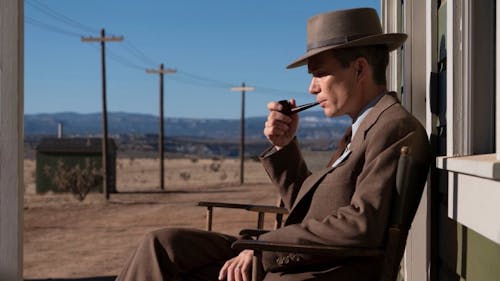Christopher Nolan’s cinematic triumph ‘Oppenheimer’ proves worth long wait

Christopher Nolan's latest film, "Oppenheimer," is by far the best film of the summer. "Oppenheimer" trumps any of its competitors solely by having a mastermind like Nolan to turn a predetermined plot into a narrative that gracefully unravels the events of the atomic bomb's invention and its fiery aftermath.
Despite the fact that the film is based on J. Robert Oppenheimer's life, Nolan took plenty of creative liberties with the script. Of course, with any film based on true events, there will always be something that didn't happen in real life the way it's portrayed in the film.
With "Oppenheimer," there are a few minor changes Nolan made to add substance to certain scenes. But the biggest split from reality Nolan has in the film (and really the only one that, in my opinion, changes things) is having Oppenheimer consult Albert Einstein (Tom Conti) on the atomic bomb. In reality, Oppenheimer took counsel with fellow physicist Arthur Compton. Of course, choosing Einstein makes for more cinematic beats.
As interesting as it is to see Oppenheimer and Einstein's relationship on the big screen, having a more accurate representation of the creation of the atomic bomb would have been preferred.
But I don't think Nolan should have cut Einstein's role due to his critical conversation with Oppenheimer by the lake, a scene based on true events. And Nolan's inclusion of that conversation serves to increase the tension surrounding Lewis Strauss' (Robert Downey Jr.) feud with Oppenheimer and his eventual downfall.
The film's cast is also completely stacked with what seems like every actor in Hollywood. There's an overwhelming amount of characters to keep track of, which can be tricky for the audience.
Even though it's a bit difficult to keep track of each individual character, once they're all grouped into three different categories — scientists, politicians and military officials — the film is easy enough to understand.
The way Nolan tackled each scene and the characters in them is a highly admirable undertaking. The film goes back and forth between black-and-white scenes and scenes in color. Strauss' objective viewpoint of the events is told from the black-and-white scenes, while the scenes in color represent Oppenheimer's subjective view of his experience.
This alone is a fascinating way to let the events come to fruition, but what makes it so unique is that there is no black-and-white filter on the scenes. Nolan had Kodak create the first-ever black-and-white IMAX film stock. And this isn't the only groundbreaking or mind-blowing accomplishment "Oppenheimer" has managed to achieve.
Nolan decided not to use any computer-generated imagery (CGI) for the film. One question that may come to mind after learning this is how Nolan created a 200-foot-high explosion without CGI. While this feat is impressive, the true visual is the film's depiction of Oppenheimer's visions of a subatomic universe.
In addition to the high quality of its production, it was revealed that "Oppenheimer" was shot in only 57 days. All the groundwork Nolan laid down seems impressive — and it is — but none of it means anything if the film itself isn't making people leave the theater blown away. Considering you can actually feel the explosion in theaters, I think "Oppenheimer" accomplished that task both literally and figuratively.
While it's a film that could use a rewatch to grasp a better understanding of what Nolan has created, it manages to captivate even on the first watch. It doesn't feel as long as it is and it looks like it had a bigger budget than it did. "Oppenheimer" hits every mark, and there isn't a scene that feels out of place or lacking in the wow factor so apparent throughout the whole film.
"Oppenheimer" is a solid biopic that stands out among the "based on a true story" genre. Nolan's latest is one that demands to be experienced in a theater so one can appreciate a masterclass in modern cinema.



